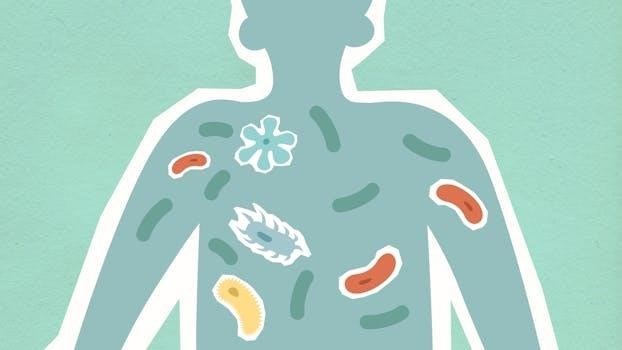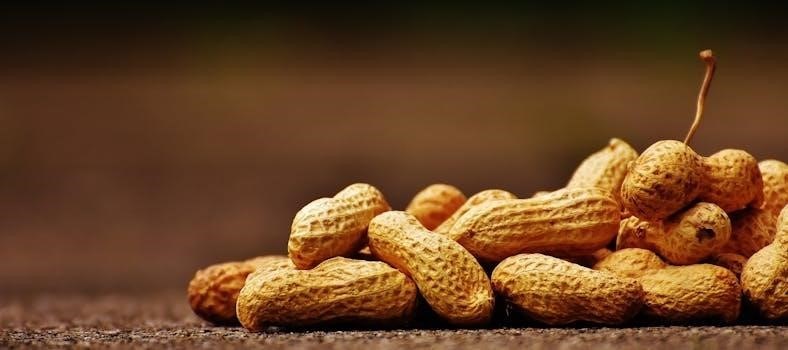Cell membranes are dynamic structures that control the passage of substances. They separate the cell’s interior from the external environment. Understanding membrane transport is crucial for comprehending cellular function, as it facilitates the movement of essential molecules and waste products, ensuring cell survival.
Overview of Membrane Transport
Membrane transport is a fundamental process vital for cellular life. It encompasses the various mechanisms by which substances move across the cell membrane, a lipid bilayer embedded with proteins. This movement is essential for maintaining cellular homeostasis, enabling cells to acquire nutrients, eliminate waste, and communicate with their surroundings. The complexity of membrane transport is due to the diverse array of molecules that must cross the membrane, each with unique properties such as size, charge, and polarity. These molecules can traverse the membrane via different pathways, either passively, following concentration gradients, or actively, requiring cellular energy. Understanding the principles of membrane transport is key to comprehending how cells function at a fundamental level. The cell membrane acts as a selectively permeable barrier, allowing certain molecules to pass through while restricting others, thereby regulating the internal environment of the cell. This intricate system ensures that cells can effectively carry out their various functions, maintaining a balance between the intracellular and extracellular milieu.
Importance of Cell Membrane Transport
Cell membrane transport is critically important for numerous biological processes. It ensures the proper functioning of cells by controlling the movement of molecules in and out of the cell. This transport is essential for nutrient uptake, allowing cells to obtain necessary building blocks for growth and energy production. Furthermore, it plays a crucial role in waste removal, preventing the accumulation of harmful byproducts of cellular metabolism. The regulation of ion concentrations across the cell membrane is vital for maintaining cellular excitability and nerve impulse transmission. Additionally, membrane transport facilitates cell-to-cell communication by allowing the passage of signaling molecules. The selective permeability of the cell membrane is dependent on transport mechanisms, ensuring that cells can maintain a stable internal environment and adapt to changing external conditions. Proper membrane transport is also fundamental in the process of photosynthesis and respiration, where specific molecules need to move across membranes for energy production. Therefore, any disruption in membrane transport can lead to severe cellular dysfunction and disease. In summary, cell membrane transport is indispensable for cellular survival, function, and communication.

Passive Transport Mechanisms
Passive transport involves the movement of substances across cell membranes without requiring cellular energy. This process relies on the concentration gradient, moving molecules from an area of high concentration to an area of low concentration.
Simple Diffusion Across the Membrane
Simple diffusion is a fundamental passive transport mechanism where molecules move directly across the cell membrane, without the aid of transport proteins. This process is driven by the concentration gradient, meaning substances travel from areas where they are highly concentrated to areas of lower concentration until equilibrium is reached. Small, nonpolar molecules, such as oxygen and carbon dioxide, readily pass through the lipid bilayer of the membrane via simple diffusion. These molecules dissolve in the membrane and move across following their concentration gradient. The rate of diffusion is influenced by factors such as temperature, molecule size, and the concentration gradient. The cell membrane’s flexibility and chemical structure facilitate this process, allowing the efficient exchange of gases and other small lipid-soluble molecules. This mechanism is crucial for maintaining cellular homeostasis by facilitating the movement of essential gases and waste products across the membrane. Simple diffusion does not require the cell to expend energy, making it an energy-efficient means of transport.
Facilitated Diffusion via Proteins
Facilitated diffusion is a passive transport mechanism that relies on membrane proteins to assist the movement of molecules across the cell membrane. Unlike simple diffusion, which is limited to small, nonpolar molecules, facilitated diffusion allows larger or polar molecules to cross the membrane. This process utilizes two main types of proteins⁚ channel proteins and carrier proteins. Channel proteins form hydrophilic pores that allow specific ions or small molecules to pass through, while carrier proteins bind to specific molecules, undergo a conformational change, and release the molecule on the other side of the membrane. Facilitated diffusion, like simple diffusion, is driven by the concentration gradient, meaning it does not require the cell to expend energy. It is a selective process, as each protein is specific to the molecules it transports. This mechanism is crucial for the uptake of essential nutrients and the removal of waste products that cannot cross the membrane on their own. The rate of facilitated diffusion is affected by the availability of transport proteins and the concentration gradient of the transported molecule.
Osmosis and Water Movement
Osmosis is a specialized type of passive transport that specifically deals with the movement of water across a semipermeable membrane, such as a cell membrane. Water moves from an area of high water concentration (low solute concentration) to an area of low water concentration (high solute concentration). This movement is driven by the difference in water potential, or osmotic pressure, between two solutions. Osmotic pressure is the force that tries to balance the solute concentrations on either side of a membrane. Cells maintain their shape and volume by regulating osmosis; otherwise, they would swell or shrink. The movement of water through the membrane is often facilitated by specialized channel proteins called aquaporins. Osmotic pressure is influenced by the number of dissolved solute particles in a solution, not the type of solute. Therefore, a solution with a higher solute concentration will have a higher osmotic pressure and tend to draw water into it. This is a critical process for maintaining cellular hydration and turgor pressure in plant cells.

Active Transport Mechanisms
Active transport is a crucial process where cells expend energy, typically from ATP, to move molecules against their concentration gradient. This mechanism is vital for maintaining cellular homeostasis and establishing electrochemical gradients for various cellular activities.
Active Transport Processes
Active transport mechanisms are essential for cells to move substances against their concentration gradients, requiring energy input, typically in the form of ATP hydrolysis. These processes are mediated by specific transport proteins embedded in the cell membrane. Primary active transport directly utilizes ATP to move molecules, such as the sodium-potassium pump which maintains ion gradients essential for nerve impulse transmission. Secondary active transport, on the other hand, uses the electrochemical gradient created by primary active transport to move other substances, such as the uptake of glucose by sodium-glucose symporters. These processes are crucial for maintaining cellular homeostasis, nutrient uptake, and waste removal. Active transport can involve the movement of ions, small molecules, and even larger particles via specialized protein transporters. The energy expenditure in active transport is vital for cells to establish and maintain these concentration gradients, allowing them to perform their functions effectively. These processes are complex and finely regulated to respond to cellular needs.

Energy Requirements for Active Transport
Active transport necessitates a direct or indirect input of cellular energy, primarily in the form of adenosine triphosphate (ATP). This energy is crucial because active transport moves substances against their concentration gradient, from an area of lower concentration to one of higher concentration, a process that thermodynamically requires energy input. The hydrolysis of ATP provides the necessary energy to power the conformational changes in transport proteins, enabling them to bind and translocate solutes across the membrane. In primary active transport, the energy from ATP is directly used, like in the sodium-potassium pump. In secondary active transport, the energy stored in electrochemical gradients, established by primary active transport, is used to move other molecules. Cells invest significant energy in active transport to maintain essential ion gradients, nutrient uptake, and waste removal. These processes are crucial for cell survival and function, highlighting the cell’s energy investment in these transport mechanisms; The precise regulation of these processes is also essential to avoid unnecessary energy expenditure.

Additional Aspects of Membrane Transport
Membrane transport involves various factors beyond simple mechanisms. These include the roles of transport proteins, membrane permeability, and regulatory processes. These aspects contribute significantly to the selective and efficient movement of molecules across cellular membranes.
Role of Transport Proteins
Transport proteins play a pivotal role in facilitating the movement of molecules across cell membranes. These proteins, which include carrier proteins and channel proteins, are integral to the cell’s ability to selectively control its internal environment. Unlike simple diffusion, which only allows small, uncharged molecules to pass through the lipid bilayer, transport proteins enable the passage of larger or charged molecules that cannot readily diffuse across the membrane. Channel proteins create hydrophilic pores, allowing specific ions or small molecules to flow through, often down their concentration gradient. Carrier proteins, on the other hand, bind to the molecule being transported and undergo conformational changes to shuttle the molecule across the membrane. These transport proteins are crucial for maintaining cellular homeostasis, ensuring that essential nutrients enter the cell and waste products are efficiently removed. The specificity of these proteins is vital for cellular function, as it allows for selective permeability, preventing unwanted substances from entering while ensuring the passage of necessary molecules. They are also involved in active transport, where energy is expended to move molecules against their concentration gradient.
Membrane Permeability Factors
Several factors influence the permeability of cell membranes, determining which substances can pass through and at what rate. The lipid composition of the membrane plays a significant role, as molecules that are soluble in lipids can more easily diffuse across the bilayer. The size and charge of solute particles are also critical; smaller, uncharged molecules generally pass through more readily than larger, charged ones. Temperature can affect membrane fluidity and permeability, with higher temperatures typically increasing permeability. The presence of transport proteins is a key factor as well; these proteins provide pathways for molecules that cannot otherwise cross the membrane. Additionally, the concentration gradient of a substance influences its movement; molecules tend to move from areas of higher concentration to lower concentration. The electrochemical gradient, which considers both concentration and electrical charge, also affects the movement of charged particles. The organization of membrane lipids and proteins contributes to its overall permeability. These factors work together to determine which molecules are able to cross, and at what rate, thus ensuring the cell maintains its internal environment.
Regulation of Membrane Transport
The regulation of membrane transport is crucial for maintaining cellular homeostasis and responding to changing environmental conditions. Cells employ various mechanisms to control the movement of substances across their membranes. One key method involves the modulation of transport protein activity. This can be achieved through allosteric regulation, where binding of a molecule to a protein alters its conformation and transport rate. Covalent modification, such as phosphorylation, can also affect protein function. Gene expression changes can alter the number of transport proteins present in the membrane, providing a longer-term control mechanism. Furthermore, cells can regulate membrane permeability by modifying the lipid composition. For instance, changing the saturation levels of fatty acids in phospholipids can influence membrane fluidity, thus affecting the passage of molecules. Intracellular signaling pathways also play a vital role by initiating cascades that ultimately impact transport processes. These regulatory mechanisms ensure that membrane transport is dynamically adjusted to meet the cell’s changing needs, allowing for precise control over the cellular environment.


